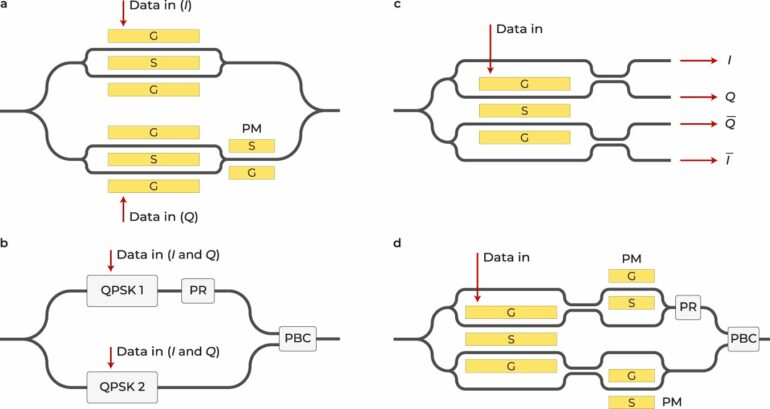Whether you’re battling foes in a virtual arena or collaborating with colleagues across the globe, lag-induced disruptions can be a major hindrance to seamless communication and immersive experiences.
That’s why researchers with the University of Central Florida’s College of Optics and Photonics (CREOL) and the University of California, Los Angeles, have developed new technology to make data transfer over optical fiber communication faster and more efficient.
Their new development, a novel class of optical modulators, is detailed in a new study published recently in the journal Nature Communications. Modulators can be thought of as like a light switch that controls certain properties of data-carrying light in an optical communication system.
“Carrying torrents of data between internet hubs and connecting servers, storage elements, and switches inside data centers, optical fiber communication is the backbone on which the digital world is built,” says Sasan Fathpour, the study’s co-author and CREOL professor. “The basic constituents of such links, the optical fiber, semiconductor laser, optical modulator and photoreceiver, all place limits on the bandwidth and the accuracy of data transmission.”
Fathpour says particularly the dispersion of optical fibers, or signal distortion over long distances, and noise of semiconductor lasers, or unwanted signal interference, are two fundamental limitations of optical communication and signal processing systems that affect data transmission and reliability.
He says their research has invented a unique class of optical modulators that simultaneously address both limitations by taking advantage of phase diversity, or varied timing of signals, and differential operations, or comparison of light signals.
By doing so, the researchers have created an advanced “light switch” that not only controls data transmission but does so while comparing the amount and timing of data moving through the system to ensure accurate and efficient transmission.
“Dubbed four-phase electrooptic modulators, the circuit is demonstrated on thin-film lithium niobate, which is an ultracompact platform for integrated photonic applications, including optical communication,” Fathpour says.
The concepts of phase diversity and differential operation existed before this research and have been explored by the UCLA team, he says.
“The problem is that off-the-shelf optical components and existing modulator architectures are not capable of achieving these two operations simultaneously,” Fathpour says. “The compactness of the thin-film lithium niobate platform allows tight integration of several components on the same small chip and helped shaping up the concept of four-phase electrooptic modulators.”
Bahram Jalali, a distinguished professor emeritus and Fang Lu Chair in Engineering in the Electrical and Computer Engineering Department at UCLA, says the concept originated from 25 years of research into time-stretch instruments, an optical slow-motion technique that stands as the most effective method for capturing ultrafast single-shot events.
“Invented at UCLA in the 1990s, time-stretch technology has yielded breakthroughs, such as the creation of the world’s fastest spectrometers, cameras, lidars, velocimeters, oscilloscopes, and more, ultimately uncovering optical rogue waves and the introduction of innovative blood screening microscopes, among other advancements,” Jalali says. “This new electrooptic modulator architecture culminated from the quest to create improved methods for encoding ultrafast data onto a laser beam to enable time stretch instruments with high bandwidth and high sensitivity.”
How the research was performed
The four-phase electrooptic modulator was analyzed within the context of a time-stretch system used for analyzing signal processing, and a comprehensive analytical model was developed to explain its operation. The technology was also optimized for electro-optic bandwidth and modulation efficiency using simulation tools for fine-tuning.
The application of the four-phase electrooptic modulator in optical communication was also explored. It was shown that the four-phase electrooptic modulator can eliminate common mode noise and dispersion, and simulation results demonstrated its ability to improve signal quality and power budget in optical communication systems.
Ehsan Ordouie, Ph.D. was a doctoral student in optics and photonics when the research was conducted and is the study’s lead author. He worked on mathematical modeling, device simulations, chip design, fabrication and more.
He says the innovative device enables both phase diversity and differential operations on a single photonic integrated circuit, thereby canceling the dispersion penalty, or signal quality degradation, and noise in optical communication links.
“Our experiments demonstrate that this approach eliminates the inherent nulls in the frequency response, which is a significant advancement for photonic time-stretch systems and coherent optical communication systems,” Ordouie says.
“Although the proposed modulator is more complex than standard ones, leading to a larger chip size and potentially lower fabrication yield, we believe that the advantages of phase diversity and differential operations justify the added complexity. This breakthrough represents a noteworthy advancement in the practical implementation of photonic systems and opens up new possibilities for faster and more efficient data communication and acquisition.”
Study co-authors also included Tianwei Jiang and Tingyi Zhou with the University of California, Los Angeles; UCF optics and photonics doctoral students Farzaneh Juneghani and Mahdi Eshaghi; and former graduate research assistant Milad Vazimali, Ph.D.
More information:
Ehsan Ordouie et al, Differential phase-diversity electrooptic modulator for cancellation of fiber dispersion and laser noise, Nature Communications (2023). DOI: 10.1038/s41467-023-41772-y
Provided by
University of Central Florida
Citation:
New technology could reduce lag, improve reliability of online gaming, meetings (2023, October 4)



